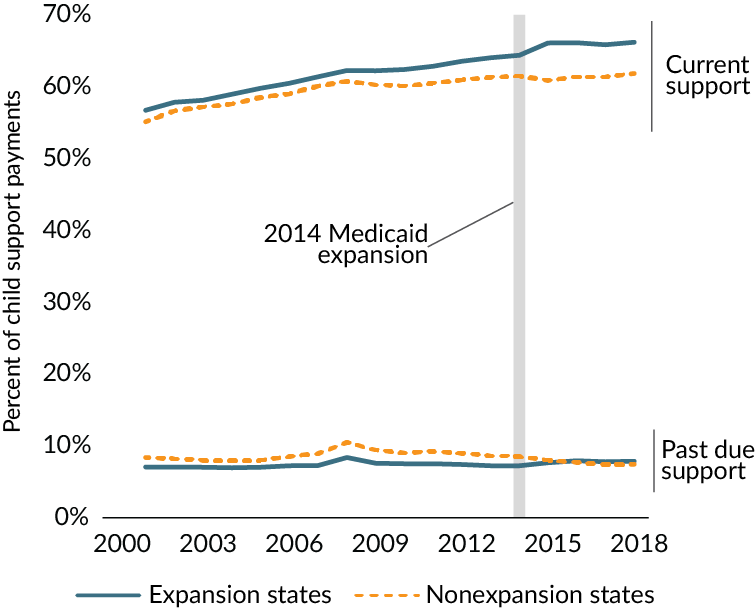- Lindsey Bullinger, and edited by Eleanor Pratt
- January 2021
- Fast Focus Research/Policy Brief No. 50-2021

According to a recent study by Lindsey Bullinger, the Affordable Care Act (ACA) Medicaid expansions improved some child support outcomes. States that expanded Medicaid experienced larger increases in payment of both past due and current child support than non-expansion states. In addition, unmarried mothers with a child support order received more child support if they lived in an expansion state than similar mothers not living in expansion states.
Connections between access to insurance and child support outcomes is a relatively new topic of study. The variation in ACA Medicaid expansions across states and over time provided an opportunity to examine the effects of expansion on child support outcomes.[1] This brief outlines the connections between child support and the ACA expansion, highlights the study’s findings, and discusses policy implications and future areas of study.
Why would access to health insurance affect child support payments?
Child support is a substantial source of income for custodial parents. When poor custodial parents receive their full child support payment, that support accounts for nearly 60% of their annual income.[2] However, child support often goes unpaid by noncustodial parents due to their own financial insecurity. Indeed, only 43% of all custodial parents with child support agreements receive their full payments.[3] Child support obligations often go unfulfilled because noncustodial parents often experience un- or under-employment, low earnings, and high debt. In fact, prior research has found that noncustodial parents with high levels of debt, especially medical debt,[4] are less able to meet child support payments and may be less willing to cooperate with child support enforcement agencies.[5] When noncustodial parents do not make payments, child support agencies often take punitive approaches to enforcement such as asset seizure, revocation of driver’s licenses, withholding unemployment compensation, work requirements, and even imprisonment.[6]
Bullinger hypothesizes that the Medicaid expansions could enable noncustodial parents to pay child support. Notably, access to health insurance reduces financial hardship,[7] resulting in less debt, fewer evictions, and bankruptcies.[8] Increased health coverage also increases access to care, potentially improving health outcomes which may increase employment,[9] and reduces crime due to substance use disorder treatment.[10] Finally, Medicaid expansions may affect child support payments because of rules that require custodial parents to work with child support enforcement agencies in order to be eligible to receive coverage for themselves and their children.[11]
As of 2019, 37 states had chosen to expand Medicaid coverage to low-income, nonelderly, nondisabled adults without dependent children.[12] From 2014 to 2018, these expansions increased health insurance eligibility, coverage, and access to health care, especially among men without dependent children, many of whom have child support obligations.[13]
- An 8.5% increase in past due child support paid to custodial families;
- A 2.2% increase in current child support paid to custodial families;
- An 8.6% increase in the likelihood of child support receipt among unmarried mothers.
Medicaid expansions increased the amount of past due support and current support received by custodial families but did not affect whether child support was paid
In a state-level analysis, Bullinger found that although the ACA Medicaid expansions did not increase the number of noncustodial parents who pay child support, it did increase the amount of support those parents paid. Figure 1 shows trends in the amount of child support paid relative to the amount that is due for both current support and past due support (arrears) in expansion states and non-expansion states. Bullinger finds that expansion states saw an 8.5% increase in the amount of payments made toward arrears compared to the pre-ACA period (2001-2013). This roughly translates to an annual increase of $12.3 million in payment toward arrears. Current child support payments to custodial families also increased by about 2.2% compared to the pre-ACA period, resulting in roughly $7.4 million more each year paid toward current child support after the implementation of the ACA.[14]
Medicaid expansions resulted in an increase in the likelihood of child support receipt among unmarried mothers
In an individual-level analysis of unmarried mothers, Bullinger found that the Medicaid expansions resulted in an 8.6% increase in the likelihood of child support receipt. In all, about 940,000 additional mothers received support, which benefitted at least 1.9 million children. Bullinger also found overlap between mothers who gained Medicaid coverage from the ACA and those who received child support, suggesting that increases in child support receipt could be related to the requirement that custodial parents cooperate with child support to receive Medicaid coverage for themselves and their children.
The fact that the analysis suggests that unmarried custodial mothers are more likely to receive child support payments even though noncustodial parents are, on average, no more likely to make child support payments might seem a bit puzzling. Bullinger identifies several possible explanations: first, the payments identified in the analysis of unmarried mothers may be informal support not captured through the Office of Child Support Enforcement data used for the noncustodial parent analysis; second, a noncustodial parent with orders for multiple children in different custodial families may change how they pay child support depending on which children have access to Medicaid, which also changed as a result of the ACA; third, state pass-through policies may dictate whether child support payments make it into the pockets of custodial families, another difference between what is paid and what is received; and finally, the samples of the two analyses are different and unmarried mothers may have been differentially affected than all parents involved in the child support enforcement program.
Conclusions and Policy Implications
This study highlights the interconnections between social programs and pushes policymakers to consider the broader context in which their programs operate. It focuses on two of the largest programs in the United States: Medicaid, one of the largest federal antipoverty programs, which served 74 million people in 2018; and child support, which served 14.3 million children in 2019[15] and has the potential to affect an additional 8.1 million children who have a parent living outside their household but do not receive child support.[16]
These findings indicate that programs outside of traditional child support enforcement measures, like expanded access to health insurance, may increase a noncustodial parent’s financial ability to pay more child support. Better understanding of cross-program participation and the interactions between child support, Medicaid, and other social programs may help to improve outcomes in child support and child and family well-being more broadly.
- Further examination of the potential mechanisms by which the ACA’s Medicaid expansions affect child support, including reductions in debt, use of more stable financial services, the income effect, and programmatic features of Medicaid expansion.
- Further attention to how increased child support payments due to Medicaid expansions impact broader indicators of child and family well-being.
Eleanor Pratt is freelance Writer and Editor at IRP and Grant Writer at Heartland Alliance.
Notes
[1]Bullinger compares both state-level and individual-level outcomes using difference-in-differences (DD) and synthetic control group approaches. The author compared states that expanded Medicaid with non-expansion states, examined trends across states pre- and post-expansion, and controlled for the state’s economic health, social safety net support, political affiliation, and policy environment.
[2]Grall, T. “Custodial Mothers and Fathers and Their Child Support: 2015,” (Current Population Reports No. P60-262) Washington, D.C.: U.S. Census Bureau, 2018.
[3]Grall, “Custodial Mothers and Fathers and Their Child Support: 2015.”
[4] Cancian, M., Heinrich, C. J., and Chung, Y. “Discouraging Disadvantaged Fathers’ Employment: An Unintended Consequence of Policies Designed to Support Families,” Journal of Policy Analysis and Management 32 (2013): 758–784.
[5]Bartfeld, J. “Arrearages, Lying-in Orders, and Child Support Compliance among Fathers of W–2 Children in Wisconsin,” working paper, University of Wisconsin–Madison, 2005; Waller, M. R., and Plotnick, R. “Effective Child Support Policy for Low-income Families: Evidence from Street Level Research,” Journal of Policy Analysis and Management 20 (2001): 89–110.
[6]Punitive approaches to child support enforcement include asset seizure; revocation of professional, driver’s, and recreational licenses like fishing or hunting licenses; unemployment compensation, disability, and pension withholding; work requirements; and even imprisonment. Pirog, M.A., and Ziol-Guest, K.M. “Child Support Enforcement: Programs and Policies, Impacts and Questions,” Journal of Policy Analysis and Management 25 (2006): 943–990.
[7]Finkelstein, A., Taubman, S., Wright, B., Bernstein, M., Gruber, J., Newhouse, J. P., Allen, H., and Baicker, K. “The Oregon Health Insurance Experiment: Evidence from the First Year,” The Quarterly Journal of Economics 127 (2012): 1057–1106.; Gross, T. and Notowidigdo, M. J. “Health Insurance and the Consumer Bankruptcy Decision: Evidence from Expansions of Medicaid,” Journal of Public Economics 95 (2011): 767–778.; Hu, L., Kaestner, R., Mazumder, B., Miller, S., and Wong, A. “The Effect of the Affordable Care Act Medicaid Expansions on Financial Wellbeing,” Journal of Public Economics 163 (2018): 99–112.; Mazumder, B. and Miller, S. “The Effects of the Massachusetts Health Reform on Household Financial Distress,” American Economic Journal: Economic Policy 8 (2016): 284–313.
[8]Caswell, K. J. and Waidmann, T. A. “The Affordable Care Act Medicaid Expansions and Personal Finance,” Medical Care Research and Review 76 (2017): 538–571; Zewde, N., Eliason, E., Allen, H., and Gross, T. “The Effects of the ACA Medicaid Expansion on Nationwide Home Evictions and Eviction-Court Initiations: United States, 2000–2016,” American Journal of Public Health 109 (2019): 1379–1383.
[9]Borgschulte, M. and Vogler, J. (2019). “Did the ACA Medicaid Expansion Save Lives?” SSRN Scholarly Paper, ID 3445818; Goldin, J., Lurie, I. Z., and McCubbin, J. “Health Insurance and Mortality: Experimental Evidence from Taxpayer Outreach,” NBER Working Paper No. 26533. Cambridge, MA: National Bureau of Economic Research, 2019; Miller, S., Altekruse, S., Johnson, N., and Wherry, L. R. “Medicaid and Mortality: New Evidence from Linked Survey and Administrative Data,” NBER Working Paper No. 26081, Cambridge, MA: National Bureau of Economic Research, 2019; Sommers, B. D., Baicker, K., and Epstein, A. M. “Mortality and Access to Care Among Adults After State Medicaid Expansions,” New England Journal of Medicine 367 (2012): 1025–1034.
[10]Wen, H., Hockenberry, J. M., and Cummings, J. R. “The effect of Medicaid expansion on crime reduction: Evidence from HIFA‐waiver expansions.” Journal of Public Economics 154 (2017): 67–94.
[11]Parents may be required to identify the noncustodial parent, establish paternity, or establish a child support agreement in order to be eligible to receive Medicaid coverage for themselves and their children.
[12]These expansions were supported by federal funding from the Affordable Care Act (ACA).
[13]Dworsky, M. and Eibner, C. “The Effect of the 2014 Medicaid Expansion on Insurance Coverage for Newly Eligible Childless Adults,” Santa Monica, CA: RAND Corporation, 2016; Simon, K., Soni, A., and Cawley, J. “The Impact of Health Insurance on Preventive Care and Health Behaviors: Evidence from the First Two Years of the ACA Medicaid Expansions,” Journal of Policy Analysis and Management 36 (2017): 390–417.
[14]Between 2001 and 2013, the average amount of back pay distributed in expansion states was $144,662,376; the average amount of current support distributed in expansion states was $369,602,503.
[15]Office of Child Support Enforcement. Fiscal Year (FY) 2019 Preliminary Data Report.
[16]Grall, “Custodial Mothers and Fathers and Their Child Support: 2015.”
Categories
Arrears & Related Policy, Child Support, Children, Health, Health Care, Orders & Payments, Transition to Adulthood
Tags
Affordable Care Act (ACA), Custodial Parents, Fathers, Medicaid, Mothers, National, Noncustodial Parents/NCP
